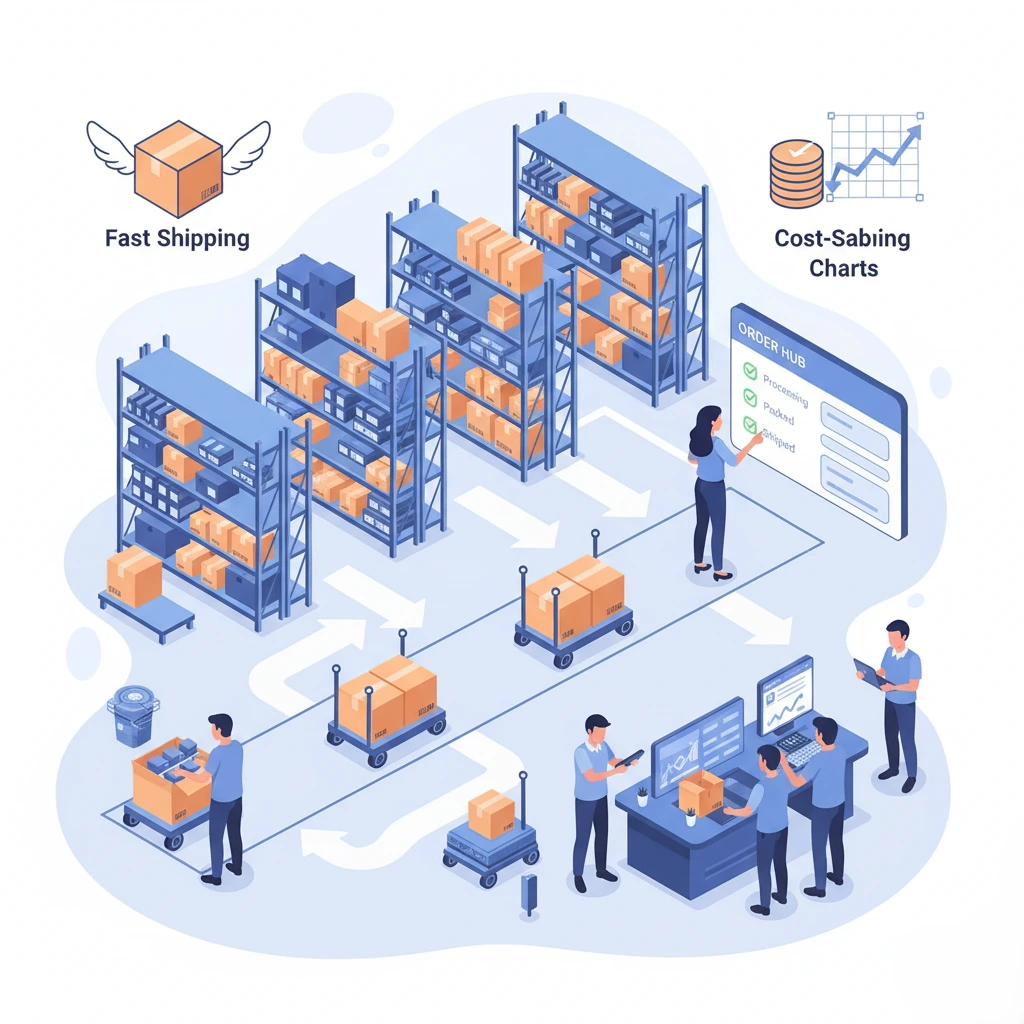Outsourcing order fulfilment has quickly become one of the most effective strategies for growing businesses that want to streamline operations, cut costs, and improve customer satisfaction. With consumer expectations higher than ever, companies need fast shipping, accurate packing, and consistent delivery performance. Managing all of this in-house can be challenging, especially for small and mid-sized brands. That’s where third-party logistics providers come in. In this blog, we’ll explore the benefits of outsourcing order fulfilment and why it could be the competitive advantage your business needs.
What Is Outsourcing Order Fulfilment?
Outsourcing order fulfilment means handing over your storage, packing, and shipping processes to a specialist logistics company, often known as a 3PL. Instead of spending time on inventory management, shipping labels, returns, and customer queries about delivery, you allow experts to handle these responsibilities. This provides your company with more time and resources to focus on growth, marketing, and product development. For many brands, outsourcing is not just a convenience—it’s a powerful step toward scaling efficiently.
Why Businesses Turn to Outsourced Fulfilment
The rise of eCommerce and shifting customer expectations have pushed companies to consider outsourcing order fulfilment. A single delay or delivery mistake can cost repeat business, affect brand reputation, and lead to negative reviews. Efficient fulfilment is no longer optional; it’s essential. Outsourcing helps businesses keep up with demand spikes, reduce operational pressure, and deliver reliable service. Whether you’re a fast-growing online shop or an established retail brand, outsourcing provides an opportunity to stay competitive without overextending internal resources.
Cost Savings and Increased Efficiency
Reduced Operating Costs
One of the biggest benefits of outsourcing order fulfilment is cost reduction. When you manage fulfilment internally, you must pay for warehouse space, staff, equipment, packing materials, and software. These expenses can quickly grow, especially during peak seasons or unexpected surges in demand. Outsourcing eliminates the need for high overheads because 3PL providers already have established infrastructure. You pay only for the space and services you use, making costs more predictable and scalable.
More Efficient Operations
Fulfilment companies are designed for high-accuracy, high-volume operations. They use advanced technology, automated systems, and trained staff to ensure orders are processed quickly and correctly. This reduces human error, improves speed, and enhances the customer experience. Instead of worrying about picking, packing, and shipping, your internal team can focus on strategic tasks that drive sales and brand development.
Faster Shipping and Better Customer Satisfaction
Access to Multiple Warehouses
A major advantage of outsourcing is access to a network of fulfilment centres. Many 3PLs operate multiple warehouses across regions or even countries. This allows your products to be stored closer to your customers, reducing shipping times and costs. Faster delivery leads to higher customer satisfaction, which increases loyalty and repeat purchases.
Improved Delivery Performance
Fulfilment providers have strong relationships with major carriers and often negotiate discounted rates. This means your customers benefit from faster shipping at competitive prices. Outsourcing also ensures consistent delivery performance during busy periods like holidays, which can be difficult for small businesses to manage in-house.
Scalability and Flexibility for Growth
Easily Handle Seasonal Surges
If your business experiences seasonal peaks, outsourcing order fulfilment gives you the flexibility to scale up or down as needed. A 3PL can quickly adapt to changing order volumes without requiring you to hire temporary staff or extend warehouse space. This flexibility helps maintain smooth operations during high-demand periods.
Support for Business Expansion
Outsourcing allows your business to grow without logistical limitations. Whether you’re launching new products, expanding into new markets, or entering international sales channels, fulfilment partners can support you with the necessary infrastructure. Instead of worrying about how to manage bigger operations, you can focus on expanding your brand.
Access to Advanced Technology
Real-Time Inventory Tracking
Most fulfilment providers use sophisticated inventory management systems that allow you to track stock levels, order status, and shipping updates in real time. This level of visibility is essential for making informed decisions about product restocking, marketing campaigns, and forecasting. Having accurate data at your fingertips helps prevent stockouts and overselling.
Automation and Optimisation
Automation is a key component of modern order fulfilment. From automatic order routing to smart packaging solutions, fulfilment centres use technology to optimise every step of the process. This increases accuracy, reduces delays, and ensures efficient operations. For small businesses lacking their own advanced systems, outsourcing provides access to tools that would otherwise be too costly.
Better Return Management
Smooth and Hassle-Free Returns
Handling returns can be time-consuming and complicated. Outsourcing return logistics ensures that items are inspected, processed, restocked, or disposed of according to your policies. A seamless returns process boosts customer trust and improves the overall shopping experience.
Data Insights from Returns
3PLs also provide detailed reports on return trends, helping you identify product defects, sizing issues, or packaging problems. This insight helps you improve product quality and reduce future returns.
More Time to Focus on What Matters
Focus on Core Business Activities
When logistics is handled by professionals, you gain more time to focus on marketing, product development, customer engagement, and other high-value tasks. This leads to stronger growth and a better use of internal resources.
Reduced Stress and Workload
Managing fulfilment can be overwhelming, especially when order volumes rise. Outsourcing reduces stress and workload for your team, creating a more efficient and focused work environment.
How Outsourcing Order Fulfilment Strengthens Your Brand
Enhances Professionalism
A smooth and reliable delivery experience reflects positively on your brand. Customers remember brands that ship quickly, communicate clearly, and deliver without issues. Outsourcing helps maintain a consistent, professional standard of service.
Supports Long-Term Growth
With better logistics, your business is equipped to handle long-term growth. Outsourced fulfilment provides the stability and support you need to evolve, expand, and stay ahead of competitors.
Conclusion
Outsourcing order fulfilment offers countless advantages, from reducing costs and improving efficiency to enhancing customer satisfaction and supporting business expansion. By partnering with a reliable 3PL provider, you gain access to advanced technology, expert support, and scalable solutions that help your business grow smoothly and sustainably. In a fast-paced eCommerce world, the brands that succeed are the ones that work smarter—not harder. Outsourcing fulfilment is one of the smartest strategies you can adopt to ensure long-term success and create a seamless experience for your customers.




